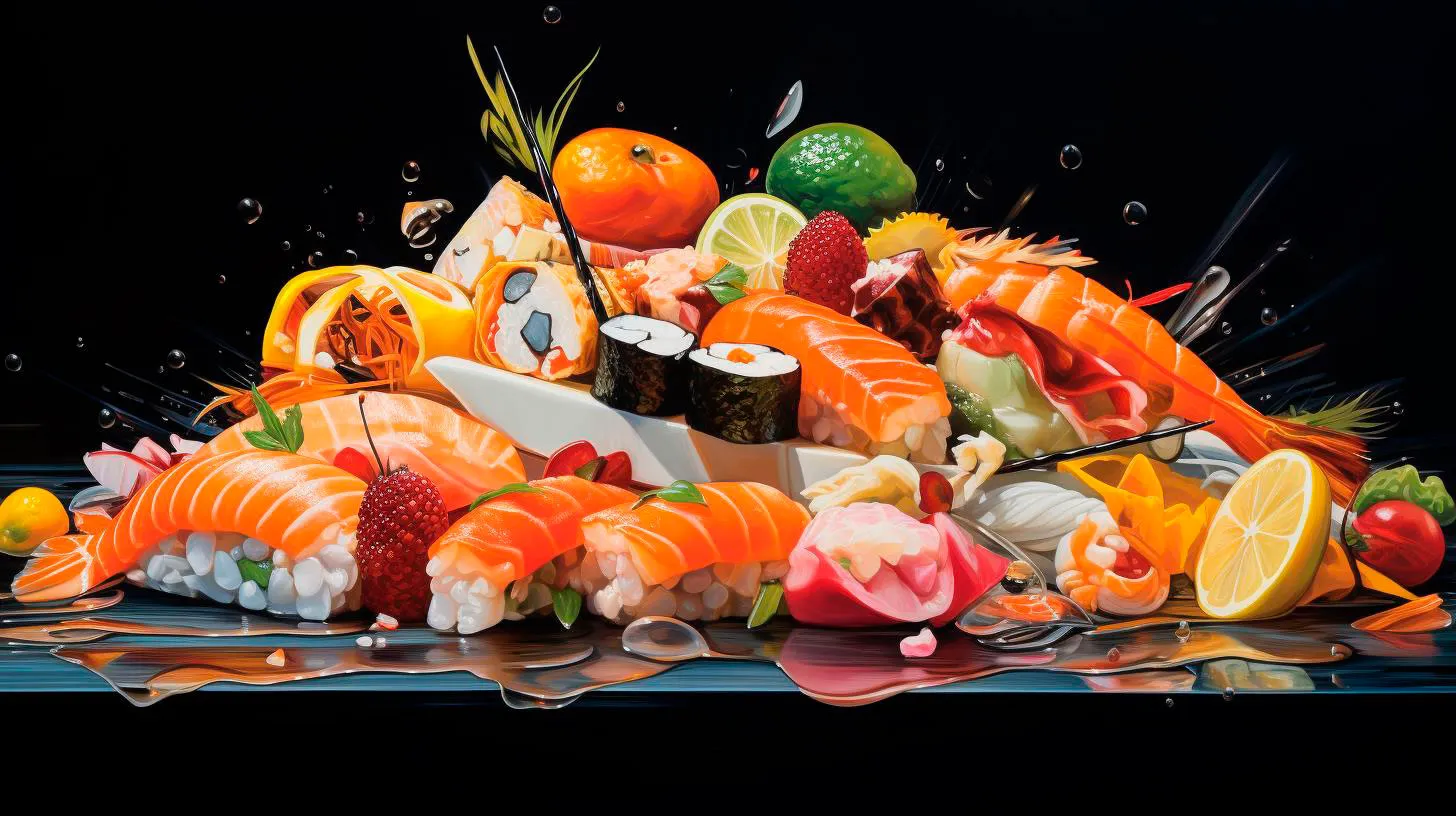The Art of Using Sushi Chopsticks
In this article, we will guide you through the art of using sushi chopsticks, providing you with tips and techniques to elevate your sushi dining experience.
The Right Chopsticks
Before we delve into the techniques, it’s important to start with the right chopsticks. Traditional Japanese chopsticks are made of wood or bamboo, offering a lightweight and comfortable grip. These materials help to prevent your sushi from slipping, making it easier to handle. Additionally, wooden chopsticks are eco-friendly, further enhancing your dining experience.
Key Takeaway:
- Opt for traditional wooden or bamboo chopsticks for a more authentic experience.
- Choose chopsticks with a comfortable grip to prevent sushi from slipping.
- Consider eco-friendly options to minimize your impact on the environment.
Proper Chopstick Etiquette
Before diving into the techniques, let’s touch upon some basic chopstick etiquette. When using chopsticks, remember the following:
- Do not use your chopsticks to stab or impale your food.
- Do not point with your chopsticks or wave them around.
- Do not pass food directly from your chopsticks to someone else’s chopsticks.
By adhering to these simple rules, you’ll show respect for the cultural traditions associated with sushi dining and enjoy a more authentic experience.
Techniques for Handling Chopsticks
Using chopsticks is all about finding a grip that suits you. Here are a few techniques that can help:
1. The Classic Method:
This method involves holding one chopstick between your thumb and index finger, like you would hold a pencil. Place the other chopstick parallel to the first one and hold it with your thumb and middle finger. Use your thumb, index, and middle fingers to control the top chopstick, while your ring finger acts as a fulcrum.
2. The Pinching Method:
In this method, hold one chopstick between your thumb and middle finger, while the other chopstick rests on your ring finger. Use your thumb and middle finger to control the top chopstick, and your ring finger as a fulcrum.
3. The Cross Method:
For those finding it difficult to master the classic and pinching methods, the cross method can be a useful alternative. Start by holding one chopstick like a pencil. Place the other chopstick across the first chopstick, gripping it with your thumb, index, and middle fingers. This method provides a more stable grip and can be easier for beginners.
Key Takeaway:
- Experiment with different chopstick holding techniques to find one that feels comfortable for you.
- Practice holding and maneuvering chopsticks to improve your dexterity.
Picking Up Sushi
Now that you have mastered the art of holding chopsticks, it’s time to pick up some sushi! Here’s how:
- Approach the sushi with the chopsticks held firmly but not too tightly.
- Aim the chopsticks at the middle of the sushi piece you want to pick up.
- Using a gentle and controlled motion, squeeze the chopsticks together to grip the sushi.
- Lift the sushi piece off the plate and bring it towards your mouth.
- Enjoy your delicious sushi!
Remember to take your time and be patient. With practice, you’ll become more proficient in picking up sushi with chopsticks.
Key Takeaway:
- Aim for the middle of the sushi piece to ensure a secure grip.
- Practice using controlled pressure to pick up sushi without crushing it.
Sushi Chopsticks Etiquette
In addition to mastering the techniques, it’s essential to understand proper sushi chopstick etiquette:
- Do not rub your chopsticks together vigorously as it can be seen as offensive behavior.
- Do not leave your chopsticks sticking out of your food.
- When not using your chopsticks, rest them on a chopstick rest or the edge of your plate.
- Lastly, always remember to say “Itadakimasu” before eating your sushi as a sign of gratitude.
By following these etiquette guidelines, you’ll further enhance your sushi dining experience and demonstrate respect for Japanese culture.
Conclusion
Mastering the art of using sushi chopsticks is a skill that takes practice but is well worth the effort. By using the right chopsticks, following proper etiquette, and learning various techniques, you’ll be able to enjoy your sushi with confidence and authenticity. Remember, sushi is not only about the taste but also about the experience. So embrace the challenge of using chopsticks and elevate your sushi dining to a new level!
Exploring the Different Types of Traditional Utensils for Sushi Lovers
In this article, we will delve into the different types of traditional utensils that every sushi lover should be familiar with. Whether you are a sushi enthusiast or a curious foodie, these utensils will surely provide a deeper appreciation for this beloved Japanese cuisine.
1. Chopsticks – The Essential Tool
No sushi meal is complete without a pair of chopsticks. Known as “hashi” in Japanese, chopsticks are the primary utensils used to enjoy sushi. They are typically made from bamboo, wood, or lacquered materials, and feature a slender design with tapered ends.
Key Features of Chopsticks:
- Lightweight and easy to handle
- Precision for picking up sushi pieces
- Hygienic and prevent direct contact with food
Advantages of Using Chopsticks:
- Allows for a controlled and delicate handling of sushi
- Enhances the overall experience by providing an authentic feel
- Encourages mindfulness and focus while eating
2. Sushi Mat – Crafting Perfect Rolls
Creating perfectly rolled sushi requires skill and a sushi mat, known as a “makisu” in Japanese. This mat is primarily made from bamboo and is essential for forming tight and uniform sushi rolls.
Key Features of Sushi Mat:
- Made from bamboo, which is durable and eco-friendly
- Flexible and allows for easy maneuvering
- Textured surface prevents sushi from slipping
Advantages of Using Sushi Mat:
- Aids in achieving professional-looking sushi rolls
- Ensures uniformity and prevents fillings from falling out
- Provides stability and control while rolling
3. Soy Sauce Dish – Dipping in Flavor
One of the essential accompaniments for sushi is soy sauce. To enjoy your sushi to the fullest, a soy sauce dish is a must-have utensil. These small dishes come in various shapes and materials, including ceramic, porcelain, and lacquer.
Key Features of Soy Sauce Dish:
- Compact size to hold an ideal amount of soy sauce
- Wide enough for easy dipping
- Dishwasher safe for convenience
Advantages of Using Soy Sauce Dish:
- Prevents excess soy sauce usage, ensuring the perfect balance of flavors
- Aesthetic appeal adds to the overall presentation
- Easy to clean and maintain
4. Wasabi Dish – Adding a Punch
Wasabi, known for its strong and pungent flavor, is a staple in sushi cuisine. To serve wasabi, a small dish, typically made from ceramic or porcelain, is used. These dishes are designed to hold a small amount of wasabi paste and keep it separate from the soy sauce.
Key Features of Wasabi Dish:
- Compact size to hold a suitable portion of wasabi
- Separate compartment to prevent mixing with soy sauce
- High-quality material to maintain freshness
Advantages of Using Wasabi Dish:
- Allows for controlled addition of wasabi to achieve desired spiciness
- Keeps the soy sauce clean and free from wasabi residue
- Preserves the freshness and quality of the wasabi paste
5. Serving Plate – Presentation Matters
Serving plates, also known as “sara,” play an essential role in the presentation of sushi. These plates come in various shapes and materials, including ceramic, wood, and lacquer. They are designed to showcase the sushi pieces beautifully.
Key Features of Serving Plate:
- Sturdy and durable to hold sushi pieces
- Attractive design to enhance visual appeal
- Varied sizes to accommodate different sushi presentations
Advantages of Using Serving Plate:
- Enhances the aesthetic appeal of sushi and elevates the dining experience
- Allows for creative presentation techniques
- Can be a conversation starter and create a memorable experience
Summing It Up
Traditional utensils play a vital role in the sushi dining experience. From the precision of chopsticks to the presentation on serving plates, each utensil contributes to the authenticity and enjoyment of sushi.
By understanding the key features, advantages, and significance of these utensils, sushi lovers can gain a deeper appreciation for the craftsmanship and artistry behind this beloved cuisine.
So, the next time you indulge in sushi, take a moment to savor the flavors while appreciating the role these traditional utensils play in enhancing your culinary journey.
Discovering the History Behind Traditional Sushi Utensils
These utensils, which have a rich history dating back centuries, play a vital role in crafting and serving sushi. In this article, we explore the fascinating history behind some of the most commonly used traditional sushi utensils.
1. Hashi (Chopsticks)
One of the most recognizable utensils in Japanese cuisine, chopsticks, or hashi, have been used in the East Asian region for thousands of years. Made primarily from wood or bamboo, hashi allow for delicate and precise movement when handling sushi. The long, slender design of hashi allows diners to pick up small pieces of sushi with ease, ensuring a pleasurable and authentic eating experience.
Key Takeaway: Using chopsticks enhances the traditional Japanese dining experience by allowing for deliberate and exact handling of sushi.
2. Nigiri Sushi Mold
The nigiri sushi mold, also known as a shari nigiri-ko, is a small wooden tool used to shape the vinegared rice component of nigiri sushi. The operator presses and molds the rice to create uniformly-shaped rectangles in which various toppings are placed. With the help of nigiri sushi molds, chefs can ensure consistency and uniformity in their sushi presentation.
Key Takeaway: Nigiri sushi molds aid in shaping perfectly formed rice and ensuring uniformity in size and appearance, enhancing the visual aspect of sushi.
3. Makisu (Bamboo Rolling Mat)
The makisu, a flexible bamboo mat, is an essential tool used to make maki rolls. Maki rolls consist of a sheet of nori seaweed filled with rice, seafood, and vegetables rolled tightly using the mat. The makisu helps maintain the shape and prevent the fillings from shifting during the rolling process. This technique ensures that the beautiful presentation of sushi rolls is maintained, while also allowing for even distribution of fillings.
Key Takeaway: The makisu plays a crucial role in creating perfectly rolled maki sushi, ensuring a visually appealing presentation and consistent distribution of fillings.
4. Sashimi Knife
The sashimi knife, or yanagiba, is a long, slender knife specifically designed for slicing sashimi. Its sharpness and fine edge allow chefs to make clean, precise cuts. The traditional single-bevel design enables them to slice through raw fish with minimal effort, resulting in smooth, consistently thin slices.
Key Takeaway: The use of a sashimi knife ensures precise and clean cuts when preparing sashimi, contributing to the overall aesthetic appeal of sushi.
5. Soy Sauce Dish
In Japanese cuisine, soy sauce is a staple condiment used to enhance the flavors of sushi. To facilitate the dipping process, a small, shallow dish, known as a soy sauce dish, is used to hold the soy sauce. The dish’s size helps control the amount of soy sauce used, preventing excessive dipping and ensuring the perfect balance of flavors.
Key Takeaway: Soy sauce dishes are essential in Japanese dining, helping regulate the amount of soy sauce used and maintaining flavor balance.
Conclusion
Traditional sushi utensils have a rich history that has significantly influenced the art of sushi making. Whether it’s the precision of chopsticks, the evenness of nigiri molds, the perfect roll aided by the makisu, the clean cuts enabled by the sashimi knife, or the enhanced taste through the soy sauce dish, these utensils contribute to the holistic sushi experience. Understanding the history and purpose behind these utensils allows sushi enthusiasts to appreciate the skill and craftsmanship that goes into creating this iconic cuisine.
Tips and Tricks for Mastering Sushi Chopstick Etiquette
Using chopsticks may seem intimidating at first, but with a few tips and tricks, you’ll be able to navigate your way through a sushi meal with grace and finesse. In this article, we’ll delve into the world of sushi chopstick etiquette, providing you with essential techniques and insights to enhance your dining experience.
1. Choosing the Right Chopsticks
Before delving into the art of sushi chopstick etiquette, it’s crucial to have the right tools. Nowadays, you can find an array of chopstick materials such as wood, bamboo, metal, and even plastic. Opt for wooden or bamboo chopsticks as they provide a traditional feel and offer better grip. Additionally, make sure the chopsticks are of equal length, clean, and free from any splinters or rough edges.
2. Proper Chopstick Holding Technique
Mastering the correct way to hold chopsticks is a fundamental aspect of sushi chopstick etiquette. Follow these steps to hold chopsticks properly:
- Hold one chopstick like a pen, placing it between your thumb and index finger.
- Rest the other chopstick on your ring finger.
- Balance it with your middle finger.
- Hold the second chopstick with your thumb and index finger, like you would hold a pencil.
- Ensure the chopsticks align at the tapered end, providing a sturdy grip.
3. Respectful Gestures
When eating sushi with chopsticks, it’s important to display respectful gestures towards your dining partners and the food itself. Here are a few key gestures to keep in mind:
- Do not rub the chopsticks together as it can be seen as an insult to the chef’s craftsmanship.
- Do not use chopsticks to spear food or make gestures with them while speaking.
- Place your chopsticks on the chopstick rest provided when not in use.
4. Navigating Sushi
Sushi is often served in bite-sized pieces, making it easier to handle with chopsticks. However, when navigating sushi, it’s crucial to do it with finesse to avoid any mishaps. Follow these tips:
- Use your chopsticks to pick up the sushi piece from the plate, ensuring a gentle grip.
- Dip the fish side, not the rice side, lightly into soy sauce to enhance its flavor.
- Avoid adding excessive wasabi or soy sauce, as it can overpower the delicate flavors.
- Enjoy the sushi in one bite to fully appreciate its textures and flavors.
5. Practice Patience
Like any skill, mastering chopstick etiquette takes time and patience. Don’t be disheartened if you encounter a few difficulties initially. Keep practicing, and you’ll soon develop the necessary dexterity and control to enjoy sushi confidently.
Remember, sushi chopstick etiquette is all about respect for the food and the culinary traditions associated with it. By following these tips, you’ll not only enhance your dining experience but also gain a deeper appreciation for Japanese culture.
Key Takeaways:
- Choose wooden or bamboo chopsticks for a traditional feel and better grip.
- Hold chopsticks like a pen, with one balanced on your ring finger.
- Avoid disrespectful gestures like rubbing chopsticks together or gesturing with them while speaking.
- Pick up sushi gently, dip the fish side into soy sauce, and savor it in one bite.
- Practice patience – mastering chopstick etiquette takes time.
With these tips and tricks up your sleeve, you’ll soon be able to navigate a sushi meal with confidence and elegance. Embrace the art of chopstick etiquette, and embark on a culinary journey that transcends cultural boundaries.


